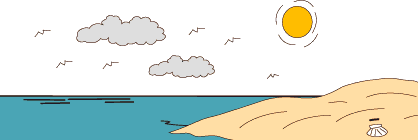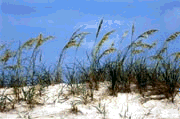
LESSON 3
AIM: What are characteristics of the shore?
MOTIVATION:
Show students a picture of a shoreline: (Picture courtesy of http://mbgnet.mobot.org/salt/sandy/indexfr.htm)
 |
Ask motivating questions such as:
1. What do you see in this picture?
2. What animals do you think live on the shore?
3. Do you think all shores look the same?
MATERIALS: Computer with Internet capabilities, word processor program such as Microsoft Word or Apple Works, printer, KidPix or Superprint, dictionary, (either online or classroom), books: Oceanography, A Golden Exploring Earth Book, Marion B. Carr, Golden Press,; Our Planet: Oceans, by Cally Oldershaw, 1994 Eagle Books, Troll Associates.
PROCEDURE:
1. Introduce vocabulary: beach, shoreline, sand dune, sea oats, middle beach, upper beach, mollusks, crustaceans, tidal pools, high tide, and low tide. Children can find the definitions from http://m-w.com/ or http://mbgnet.mobot.org/salt/sandy/indexfr.htm).
2. Have children go on line to http://mbgnet.mobot.org/salt/sandy/indexfr.htm and use the information there to fill in the database below. (Pictures were taken from this site).
|
|
|
|
|
|
|
Beaches on barrier islands are sandy. |
|
|
Sand dunes are big mounds of sand behind ocean beaches. The dunes closest to the ocean are called primary dunes. The dunes behind the primary dunes are called secondary dunes. | |
 |
|
Sea Oats are one of the few plants that will grow on primary dunes. The roots of sea oats hold the sand in place. The leaves stop and collect blowing sand. |
A. Middle beach: The area under water most of the time on the beach. Creatures that live here survive by burrowing into the wet sand, where they are safe from the pounding surf.
B. Upper beach: The zone above the middle beach. Tides wet this section twice a day in most places. Life here is adapted to land, sun ,and air rather than to water.
Sand dune: This area is the farthest from the water. Only the highest waves and storm waves ever reach here. Ocean life is scarce here.
ACTIVITIES:
1. Children will complete the database.
2. Children will complete the diagram.
EVALUATION:
Students will create a report of information on the animal life and plant life of each layer of the shore. They will gather their information from this website: http://web.mit.edu/corrina/tpool/tidezones.html and any other books available to them. They should include as many pictures and drawings as they can.
FOLLOW-UP:
This lesson will lead into the next lesson "What are tides?"